Version:1.0 StartHTML:000000205 EndHTML:000281169 StartFragment:000057786 EndFragment:000281131 StartSelection:000057786 EndSelection:000281109 SourceURL:https://en.wikipedia.org/wiki/Golden_ratio Golden ratio – Wikipedia
Golden ratio
From Wikipedia, the free encyclopediaJump to navigationJump to searchThis article is about the number. For the Ace of Base album, see The Golden Ratio (album). For the calendar dates, see Golden number (time).

Line segments in the golden ratio
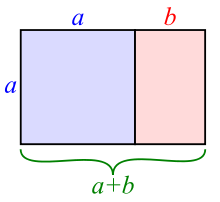
A golden rectangle with longer side a and shorter side b, when placed adjacent to a square with sides of length a, will produce a similar golden rectangle with longer side a + b and shorter side a. This illustrates the relationship a + b a = a b ≡ φ {\displaystyle {\frac {a+b}{a}}={\frac {a}{b}}\equiv \varphi }

.
In mathematics, two quantities are in the golden ratio if their ratio is the same as the ratio of their sum to the larger of the two quantities. The figure on the right illustrates the geometric relationship. Expressed algebraically, for quantities a and b with a > b > 0, a + b a = a b = def φ , {\displaystyle {\frac {a+b}{a}}={\frac {a}{b}}\ {\stackrel {\text{def}}{=}}\ \varphi ,}




where the Greek letter phi (φ {\displaystyle \varphi } or ϕ {\displaystyle \phi } ) represents the golden ratio.[a] It is an irrational number that is a solution to the quadratic equation x 2 − x − 1 = 0 {\displaystyle x^{2}-x-1=0} , with a value of: φ = 1 + 5 2 = 1.6180339887 … . {\displaystyle \varphi ={\frac {1+{\sqrt {5}}}{2}}=1.6180339887\ldots .}

The golden ratio is also called the golden mean or golden section (Latin: sectio aurea).[2][3] Other names include extreme and mean ratio,[4] medial section, divine proportion, divine section (Latin: sectio divina), golden proportion, golden cut,[5] and golden number.[6][7][8]
Mathematicians since Euclid have studied the properties of the golden ratio, including its appearance in the dimensions of a regular pentagon and in a golden rectangle, which may be cut into a square and a smaller rectangle with the same aspect ratio. The golden ratio has also been used to analyze the proportions of natural objects as well as man-made systems such as financial markets, in some cases based on dubious fits to data.[9] The golden ratio appears in some patterns in nature, including the spiral arrangement of leaves and other plant parts.
Some twentieth-century artists and architects, including Le Corbusier and Salvador Dalí, have proportioned their works to approximate the golden ratio—especially in the form of the golden rectangle, in which the ratio of the longer side to the shorter is the golden ratio—believing this proportion to be aesthetically pleasing.
Contents
- 1Calculation
- 2History
- 3Applications and observations
- 4Mathematics
- 4.1Irrationality
- 4.2Minimal polynomial
- 4.3Golden ratio conjugate
- 4.4Alternative forms
- 4.5Geometry
- 4.6Relationship to Fibonacci sequence
- 4.7Symmetries
- 4.8Other properties
- 4.9Decimal expansion
- 5Pyramids
- 6Disputed observations
- 7See also
- 8References
- 9Further reading
- 10External links
Calculation
| List of numbersIrrational numbersζ(3)√2√3√5φeπ | |
| Binary | 1.1001111000110111011… |
| Decimal | 1.6180339887498948482…[1] |
| Hexadecimal | 1.9E3779B97F4A7C15F39… |
| Continued fraction | 1 + 1 1 + 1 1 + 1 1 + 1 1 + ⋱ {\displaystyle 1+{\cfrac {1}{1+{\cfrac {1}{1+{\cfrac {1}{1+{\cfrac {1}{1+\ddots }}}}}}}}} |
| Algebraic form | 1 + 5 2 {\displaystyle {\frac {1+{\sqrt {5}}}{2}}} |

The Greek letter phi symbolizes the golden ratio. Usually, the lowercase form (φ or φ) is used. Sometimes the uppercase form (Φ {\displaystyle \Phi }

) is used for the reciprocal of the golden ratio, 1/φ.[10]
Two quantities a and b are said to be in the golden ratio φ if a + b a = a b = φ . {\displaystyle {\frac {a+b}{a}}={\frac {a}{b}}=\varphi .}

One method for finding the value of φ is to start with the left fraction. Through simplifying the fraction and substituting in b/a = 1/φ, a + b a = a a + b a = 1 + b a = 1 + 1 φ . {\displaystyle {\frac {a+b}{a}}={\frac {a}{a}}+{\frac {b}{a}}=1+{\frac {b}{a}}=1+{\frac {1}{\varphi }}.}

Therefore, 1 + 1 φ = φ . {\displaystyle 1+{\frac {1}{\varphi }}=\varphi .}

Multiplying by φ gives φ + 1 = φ 2 {\displaystyle \varphi +1=\varphi ^{2}}

which can be rearranged to φ 2 − φ − 1 = 0. {\displaystyle {\varphi }^{2}-\varphi -1=0.}

Using the quadratic formula, two solutions are obtained: 1 + 5 2 = 1.618 033 988 7 … {\displaystyle {\frac {1+{\sqrt {5}}}{2}}=1.618\,033\,988\,7\dots }

and 1 − 5 2 = − 0.618 033 988 7 … {\displaystyle {\frac {1-{\sqrt {5}}}{2}}=-0.618\,033\,988\,7\dots }

Because φ is the ratio between positive quantities, φ is necessarily positive: φ = 1 + 5 2 = 1.61803 39887 … {\displaystyle \varphi ={\frac {1+{\sqrt {5}}}{2}}=1.61803\,39887\dots }

History
Further information: Mathematics and artSee also: Fibonacci number § History
According to Mario Livio:
Some of the greatest mathematical minds of all ages, from Pythagoras and Euclid in ancient Greece, through the medieval Italian mathematician Leonardo of Pisa and the Renaissance astronomer Johannes Kepler, to present-day scientific figures such as Oxford physicist Roger Penrose, have spent endless hours over this simple ratio and its properties. … Biologists, artists, musicians, historians, architects, psychologists, and even mystics have pondered and debated the basis of its ubiquity and appeal. In fact, it is probably fair to say that the Golden Ratio has inspired thinkers of all disciplines like no other number in the history of mathematics.[11]
Ancient Greek mathematicians first studied what we now call the golden ratio because of its frequent appearance in geometry;[12] the division of a line into “extreme and mean ratio” (the golden section) is important in the geometry of regular pentagrams and pentagons.[13] According to one story, 5th-century BC mathematician Hippasus discovered that the golden ratio was neither a whole number nor a fraction (an irrational number), surprising Pythagoreans.[14] Euclid‘s Elements (c. 300 BC) provides several propositions and their proofs employing the golden ratio[15][b] and contains the first known definition:[16]
A straight line is said to have been cut in extreme and mean ratio when, as the whole line is to the greater segment, so is the greater to the lesser.[17][c]
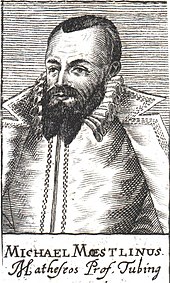
Michael Maestlin, the first to write a decimal approximation of the ratio
The golden ratio was studied peripherally over the next millennium. Abu Kamil (c. 850–930) employed it in his geometric calculations of pentagons and decagons; his writings influenced that of Fibonacci (Leonardo of Pisa) (c. 1170–1250), who used the ratio in related geometry problems, though never connected it to the series of numbers named after him.[19] Luca Pacioli named his book Divina proportione (1509) after the ratio and explored its properties including its appearance in some of the Platonic solids.[8][20] Leonardo da Vinci, who illustrated the aforementioned book, called the ratio the sectio aurea (‘golden section’).[21] 16th-century mathematicians such as Rafael Bombelli solved geometric problems using the ratio.[22]
German mathematician Simon Jacob (d. 1564) noted that consecutive Fibonacci numbers converge to the golden ratio;[23] this was rediscovered by Johannes Kepler in 1608.[24] The first known decimal approximation of the (inverse) golden ratio was stated as “about 0.6180340” in 1597 by Michael Maestlin of the University of Tübingen in a letter to Kepler, his former student.[25] The same year, Kepler wrote to Maestlin of the Kepler triangle, which combines the golden ratio with the Pythagorean theorem. Kepler said of these:
Geometry has two great treasures: one is the Theorem of Pythagoras, and the other the division of a line into extreme and mean ratio; the first we may compare to a measure of gold, the second we may name a precious jewel.
18th-century mathematicians Abraham de Moivre, Daniel Bernoulli, and Leonhard Euler used a golden ratio-based formula which finds the value of a Fibonacci number based on its placement in the sequence; in 1843 this was rediscovered by Jacques Philippe Marie Binet, for whom it was named “Binet’s formula”.[26] Martin Ohm first used the German term goldener Schnitt (‘golden section’) to describe the ratio in 1835.[27] James Sully used the equivalent English term in 1875.[28]
By 1910, mathematician Mark Barr began using the Greek letter Phi (φ) as a symbol for the golden ratio.[29][d] It has also been represented by tau (τ), the first letter of the ancient Greek τομή (‘cut’ or ‘section’).[32][33]
Between 1973 and 1974, Roger Penrose developed Penrose tiling, a pattern related to the golden ratio both in the ratio of areas of its two rhombic tiles and in their relative frequency within the pattern.[34] This led to Dan Shechtman‘s early 1980s discovery of quasicrystals,[35][36] some of which exhibit icosahedral symmetry.[37][38]
Applications and observations
Architecture
Further information: Mathematics and architecture
A 2004 geometrical analysis of earlier research into the Great Mosque of Kairouan (670) reveals a consistent application of the golden ratio throughout the design.[39] They found ratios close to the golden ratio in the overall layout and in the dimensions of the prayer space, the court, and the minaret. However, the areas with ratios close to the golden ratio were not part of the original plan, and were likely added in a reconstruction.[39]
It has been speculated that the golden ratio was used by the designers of the Naqsh-e Jahan Square (1629) and the adjacent Lotfollah Mosque.[40]
The Swiss architect Le Corbusier, famous for his contributions to the modern international style, centered his design philosophy on systems of harmony and proportion. Le Corbusier’s faith in the mathematical order of the universe was closely bound to the golden ratio and the Fibonacci series, which he described as “rhythms apparent to the eye and clear in their relations with one another. And these rhythms are at the very root of human activities. They resound in man by an organic inevitability, the same fine inevitability which causes the tracing out of the Golden Section by children, old men, savages and the learned.”[41][42]
Le Corbusier explicitly used the golden ratio in his Modulor system for the scale of architectural proportion. He saw this system as a continuation of the long tradition of Vitruvius, Leonardo da Vinci’s “Vitruvian Man“, the work of Leon Battista Alberti, and others who used the proportions of the human body to improve the appearance and function of architecture. In addition to the golden ratio, Le Corbusier based the system on human measurements, Fibonacci numbers, and the double unit. He took suggestion of the golden ratio in human proportions to an extreme: he sectioned his model human body’s height at the navel with the two sections in golden ratio, then subdivided those sections in golden ratio at the knees and throat; he used these golden ratio proportions in the Modulor system. Le Corbusier’s 1927 Villa Stein in Garches exemplified the Modulor system’s application. The villa’s rectangular ground plan, elevation, and inner structure closely approximate golden rectangles.[43]
Another Swiss architect, Mario Botta, bases many of his designs on geometric figures. Several private houses he designed in Switzerland are composed of squares and circles, cubes and cylinders. In a house he designed in Origlio, the golden ratio is the proportion between the central section and the side sections of the house.[44]
Art
See also: Mathematics and art and History of aesthetics before the 20th century

Leonardo‘s illustration of a dodecahedron from Pacioli‘s Divina proportione (1509)
Divina proportione (Divine proportion), a three-volume work by Luca Pacioli, was published in 1509. Pacioli, a Franciscan friar, was known mostly as a mathematician, but he was also trained and keenly interested in art. Divina proportione explored the mathematics of the golden ratio. Though it is often said that Pacioli advocated the golden ratio’s application to yield pleasing, harmonious proportions, Livio points out that the interpretation has been traced to an error in 1799, and that Pacioli actually advocated the Vitruvian system of rational proportions.[45] Pacioli also saw Catholic religious significance in the ratio, which led to his work’s title.
Leonardo da Vinci‘s illustrations of polyhedra in Divina proportione[46] have led some to speculate that he incorporated the golden ratio in his paintings. But the suggestion that his Mona Lisa, for example, employs golden ratio proportions, is not supported by Leonardo’s own writings.[47] Similarly, although the Vitruvian Man is often shown in connection with the golden ratio, the proportions of the figure do not actually match it, and the text only mentions whole number ratios.[48][49]
Salvador Dalí, influenced by the works of Matila Ghyka,[50] explicitly used the golden ratio in his masterpiece, The Sacrament of the Last Supper. The dimensions of the canvas are a golden rectangle. A huge dodecahedron, in perspective so that edges appear in golden ratio to one another, is suspended above and behind Jesus and dominates the composition.[47][51]
A statistical study on 565 works of art of different great painters, performed in 1999, found that these artists had not used the golden ratio in the size of their canvases. The study concluded that the average ratio of the two sides of the paintings studied is 1.34, with averages for individual artists ranging from 1.04 (Goya) to 1.46 (Bellini).[52] On the other hand, Pablo Tosto listed over 350 works by well-known artists, including more than 100 which have canvasses with golden rectangle and root-5 proportions, and others with proportions like root-2, 3, 4, and 6.[53]
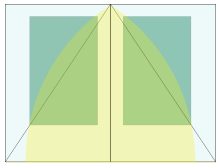
Depiction of the proportions in a medieval manuscript. According to Jan Tschichold: “Page proportion 2:3. Margin proportions 1:1:2:3. Text area proportioned in the Golden Section.”[54]
Books and design
Main article: Canons of page construction
According to Jan Tschichold,
There was a time when deviations from the truly beautiful page proportions 2:3, 1:√3, and the Golden Section were rare. Many books produced between 1550 and 1770 show these proportions exactly, to within half a millimeter.[55]
According to some sources, the golden ratio is used in everyday design, for example in the proportions of playing cards, postcards, posters, light switch plates, and widescreen televisions.[56][57][58][59]
Music
Ernő Lendvai analyzes Béla Bartók‘s works as being based on two opposing systems, that of the golden ratio and the acoustic scale,[60] though other music scholars reject that analysis.[61] French composer Erik Satie used the golden ratio in several of his pieces, including Sonneries de la Rose+Croix. The golden ratio is also apparent in the organization of the sections in the music of Debussy‘s Reflets dans l’eau (Reflections in Water), from Images (1st series, 1905), in which “the sequence of keys is marked out by the intervals 34, 21, 13 and 8, and the main climax sits at the phi position”.[62]
The musicologist Roy Howat has observed that the formal boundaries of Debussy’s La Mer correspond exactly to the golden section.[63] Trezise finds the intrinsic evidence “remarkable”, but cautions that no written or reported evidence suggests that Debussy consciously sought such proportions.[64]
Pearl Drums positions the air vents on its Masters Premium models based on the golden ratio. The company claims that this arrangement improves bass response and has applied for a patent on this innovation.[65]

Though Heinz Bohlen proposed the non-octave-repeating 833 cents scale based on combination tones, the tuning features relations based on the golden ratio. As a musical interval the ratio 1.618… is 833.090… cents (Play (help·info)).[66]
Nature

Detail of Aeonium tabuliforme showing the multiple spiral arrangement (parastichy)Main article: Patterns in natureSee also: Fibonacci number § Nature
Johannes Kepler wrote that “the image of man and woman stems from the divine proportion. In my opinion, the propagation of plants and the progenitive acts of animals are in the same ratio”.[67]
The psychologist Adolf Zeising noted that the golden ratio appeared in phyllotaxis and argued from these patterns in nature that the golden ratio was a universal law.[68][69] Zeising wrote in 1854 of a universal orthogenetic law of “striving for beauty and completeness in the realms of both nature and art”.[70]
In 2010, the journal Science reported that the golden ratio is present at the atomic scale in the magnetic resonance of spins in cobalt niobate crystals.[71]
However, some have argued that many apparent manifestations of the golden ratio in nature, especially in regard to animal dimensions, are fictitious.[72]
Optimization
The golden ratio is key to the golden-section search.
Mathematics
Irrationality
The golden ratio is an irrational number. Below are two short proofs of irrationality:
Contradiction from an expression in lowest terms

If φ were rational, then it would be the ratio of sides of a rectangle with integer sides (the rectangle comprising the entire diagram). But it would also be a ratio of integer sides of the smaller rectangle (the rightmost portion of the diagram) obtained by deleting a square. The sequence of decreasing integer side lengths formed by deleting squares cannot be continued indefinitely because the integers have a lower bound, so φ cannot be rational.
Recall that: the whole is the longer part plus the shorter part;the whole is to the longer part as the longer part is to the shorter part.
If we call the whole n and the longer part m, then the second statement above becomes n is to m as m is to n − m,
or, algebraically n m = m n − m . ( ∗ ) {\displaystyle {\frac {n}{m}}={\frac {m}{n-m}}.\qquad (*)}

To say that the golden ratio φ is rational means that φ is a fraction n/m where n and m are integers. We may take n/m to be in lowest terms and n and m to be positive. But if n/m is in lowest terms, then the identity labeled (*) above says m/(n − m) is in still lower terms. That is a contradiction that follows from the assumption that φ is rational.
By irrationality of √5


Another short proof—perhaps more commonly known—of the irrationality of the golden ratio makes use of the closure of rational numbers under addition and multiplication. If 1 + 5 2 {\displaystyle \textstyle {\frac {1+{\sqrt {5}}}{2}}} is rational, then 2 ( 1 + 5 2 ) − 1 = 5 {\displaystyle \textstyle 2\left({\frac {1+{\sqrt {5}}}{2}}\right)-1={\sqrt {5}}} is also rational, which is a contradiction if it is already known that the square root of a non-square natural number is irrational.
Minimal polynomial
The golden ratio is also an algebraic number and even an algebraic integer. It has minimal polynomial x 2 − x − 1. {\displaystyle x^{2}-x-1.}

Having degree 2, this polynomial actually has two roots, the other being the golden ratio conjugate.
Golden ratio conjugate
The conjugate root to the minimal polynomial x2 − x − 1 is − 1 φ = 1 − φ = 1 − 5 2 = − 0.61803 39887 … . {\displaystyle -{\frac {1}{\varphi }}=1-\varphi ={\frac {1-{\sqrt {5}}}{2}}=-0.61803\,39887\dots .}


The absolute value of this quantity (≈ 0.618) corresponds to the length ratio taken in reverse order (shorter segment length over longer segment length, b/a), and is sometimes referred to as the golden ratio conjugate.[10] It is denoted here by the capital Phi (Φ {\displaystyle \Phi } ): Φ = 1 φ = φ − 1 = 0.61803 39887 … . {\displaystyle \Phi ={1 \over \varphi }=\varphi ^{-1}=0.61803\,39887\ldots .}


Alternatively, Φ {\displaystyle \Phi } can be expressed as Φ = φ − 1 = 1.61803 39887 … − 1 = 0.61803 39887 … . {\displaystyle \Phi =\varphi -1=1.61803\,39887\ldots -1=0.61803\,39887\ldots .}

This illustrates the unique property of the golden ratio among positive numbers, that 1 φ = φ − 1 , {\displaystyle {1 \over \varphi }=\varphi -1,}

or its inverse: 1 Φ = Φ + 1. {\displaystyle {1 \over \Phi }=\Phi +1.}

This means 0.61803…:1 = 1:1.61803….
Alternative forms

Approximations to the reciprocal golden ratio by finite continued fractions, or ratios of Fibonacci numbers
The formula φ = 1 + 1/φ can be expanded recursively to obtain a continued fraction for the golden ratio:[73] φ = [ 1 ; 1 , 1 , 1 , … ] = 1 + 1 1 + 1 1 + 1 1 + ⋱ {\displaystyle \varphi =[1;1,1,1,\dots ]=1+{\cfrac {1}{1+{\cfrac {1}{1+{\cfrac {1}{1+\ddots }}}}}}}
![\varphi =[1;1,1,1,\dots ]=1+{\cfrac {1}{1+{\cfrac {1}{1+{\cfrac {1}{1+\ddots }}}}}}](https://wikimedia.org/api/rest_v1/media/math/render/svg/95682588ffee3530627c3a7b00ff08bbba6e97d4)
and its reciprocal: φ − 1 = [ 0 ; 1 , 1 , 1 , … ] = 0 + 1 1 + 1 1 + 1 1 + ⋱ {\displaystyle \varphi ^{-1}=[0;1,1,1,\dots ]=0+{\cfrac {1}{1+{\cfrac {1}{1+{\cfrac {1}{1+\ddots }}}}}}}
![\varphi ^{-1}=[0;1,1,1,\dots ]=0+{\cfrac {1}{1+{\cfrac {1}{1+{\cfrac {1}{1+\ddots }}}}}}](https://wikimedia.org/api/rest_v1/media/math/render/svg/165d255e32f4b9af1f9144f15302b147fc3fead2)
The convergents of these continued fractions (1/1, 2/1, 3/2, 5/3, 8/5, 13/8, …, or 1/1, 1/2, 2/3, 3/5, 5/8, 8/13, …) are ratios of successive Fibonacci numbers.
The equation φ2 = 1 + φ likewise produces the continued square root, or infinite surd, form: φ = 1 + 1 + 1 + 1 + ⋯ . {\displaystyle \varphi ={\sqrt {1+{\sqrt {1+{\sqrt {1+{\sqrt {1+\cdots }}}}}}}}.}

An infinite series can be derived to express φ:[74] φ = 13 8 + ∑ n = 0 ∞ ( − 1 ) n + 1 ( 2 n + 1 ) ! 4 2 n + 3 n ! ( n + 2 ) ! . {\displaystyle \varphi ={\frac {13}{8}}+\sum _{n=0}^{\infty }{\frac {(-1)^{n+1}(2n+1)!}{4^{2n+3}n!(n+2)!}}.}

Also: φ = 1 + 2 sin ( π / 10 ) = 1 + 2 sin 18 ∘ {\displaystyle \varphi =1+2\sin(\pi /10)=1+2\sin 18^{\circ }}

φ = 1 2 csc ( π / 10 ) = 1 2 csc 18 ∘ {\displaystyle \varphi ={1 \over 2}\csc(\pi /10)={1 \over 2}\csc 18^{\circ }}

φ = 2 cos ( π / 5 ) = 2 cos 36 ∘ {\displaystyle \varphi =2\cos(\pi /5)=2\cos 36^{\circ }}

φ = 2 sin ( 3 π / 10 ) = 2 sin 54 ∘ . {\displaystyle \varphi =2\sin(3\pi /10)=2\sin 54^{\circ }.}

These correspond to the fact that the length of the diagonal of a regular pentagon is φ times the length of its side, and similar relations in a pentagram.
Geometry

Approximate and true golden spirals. The green spiral is made from quarter-circles tangent to the interior of each square, while the red spiral is a Golden Spiral, a special type of logarithmic spiral. Overlapping portions appear yellow. The length of the side of one square divided by that of the next smaller square is the golden ratio.
The number φ turns up frequently in geometry, particularly in figures with pentagonal symmetry. The length of a regular pentagon‘s diagonal is φ times its side. The vertices of a regular icosahedron are those of three mutually orthogonal golden rectangles.
There is no known general algorithm to arrange a given number of nodes evenly on a sphere, for any of several definitions of even distribution (see, for example, Thomson problem). However, a useful approximation results from dividing the sphere into parallel bands of equal surface area and placing one node in each band at longitudes spaced by a golden section of the circle, i.e. 360°/φ ≅ 222.5°. This method was used to arrange the 1500 mirrors of the student-participatory satellite Starshine-3.[75]
Dividing a line segment by interior division
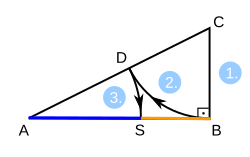
Dividing a line segment by interior division according to the golden ratio
- Having a line segment AB, construct a perpendicular BC at point B, with BC half the length of AB. Draw the hypotenuse AC.
- Draw an arc with center C and radius BC. This arc intersects the hypotenuse AC at point D.
- Draw an arc with center A and radius AD. This arc intersects the original line segment AB at point S. Point S divides the original line segment AB into line segments AS and SB with lengths in the golden ratio.
Dividing a line segment by exterior division
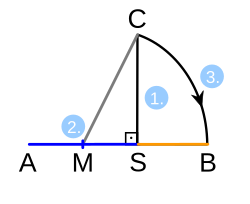
Dividing a line segment by exterior division according to the golden ratio
- Draw a line segment AS and construct off the point S a segment SC perpendicular to AS and with the same length as AS.
- Do bisect the line segment AS with M.
- A circular arc around M with radius MC intersects in point B the straight line through points A and S (also known as the extension of AS). The ratio of AS to the constructed segment SB is the golden ratio.
Application examples you can see in the articles Pentagon with a given side length, Decagon with given circumcircle and Decagon with a given side length.
Both of the above displayed different algorithms produce geometric constructions that determine two aligned line segments where the ratio of the longer one to the shorter one is the golden ratio.
Golden triangle, pentagon and pentagram
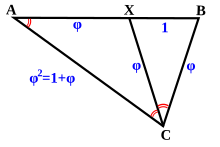
Golden triangle. The double-red-arched angle is 36 degrees, or π 5 {\displaystyle {\frac {\pi }{5}}}

radians.
Golden triangle
The golden triangle can be characterized as an isosceles triangle ABC with the property that bisecting the angle C produces a new triangle CXB which is a similar triangle to the original.
If angle BCX = α, then XCA = α because of the bisection, and CAB = α because of the similar triangles; ABC = 2α from the original isosceles symmetry, and BXC = 2α by similarity. The angles in a triangle add up to 180°, so 5α = 180, giving α = 36°. So the angles of the golden triangle are thus 36°-72°-72°. The angles of the remaining obtuse isosceles triangle AXC (sometimes called the golden gnomon) are 36°-36°-108°.
Suppose XB has length 1, and we call BC length φ. Because of the isosceles triangles XC=XA and BC=XC, so these are also length φ. Length AC = AB, therefore equals φ + 1. But triangle ABC is similar to triangle CXB, so AC/BC = BC/BX, AC/φ = φ/1, and so AC also equals φ2. Thus φ2 = φ + 1, confirming that φ is indeed the golden ratio.
Similarly, the ratio of the area of the larger triangle AXC to the smaller CXB is equal to φ, while the inverse ratio is φ − 1.
Pentagon
In a regular pentagon the ratio of a diagonal to a side is the golden ratio, while intersecting diagonals section each other in the golden ratio.[8]
Odom’s construction

Let A and B be midpoints of the sides EF and ED of an equilateral triangle DEF. Extend AB to meet the circumcircle of DEF at C.
| A B | | B C | = | A C | | A B | = ϕ {\displaystyle {\tfrac {|AB|}{|BC|}}={\tfrac {|AC|}{|AB|}}=\phi }

George Odom has given a remarkably simple construction for φ involving an equilateral triangle: if an equilateral triangle is inscribed in a circle and the line segment joining the midpoints of two sides is produced to intersect the circle in either of two points, then these three points are in golden proportion. This result is a straightforward consequence of the intersecting chords theorem and can be used to construct a regular pentagon, a construction that attracted the attention of the noted Canadian geometer H. S. M. Coxeter who published it in Odom’s name as a diagram in the American Mathematical Monthly accompanied by the single word “Behold!” [76]
Pentagram

A pentagram colored to distinguish its line segments of different lengths. The four lengths are in golden ratio to one another.
The golden ratio plays an important role in the geometry of pentagrams. Each intersection of edges sections other edges in the golden ratio. Also, the ratio of the length of the shorter segment to the segment bounded by the two intersecting edges (a side of the pentagon in the pentagram’s center) is φ, as the four-color illustration shows.
The pentagram includes ten isosceles triangles: five acute and five obtuse isosceles triangles. In all of them, the ratio of the longer side to the shorter side is φ. The acute triangles are golden triangles. The obtuse isosceles triangles are golden gnomons.
Ptolemy’s theorem

The golden ratio in a regular pentagon can be computed using Ptolemy’s theorem.
The golden ratio properties of a regular pentagon can be confirmed by applying Ptolemy’s theorem to the quadrilateral formed by removing one of its vertices. If the quadrilateral’s long edge and diagonals are b, and short edges are a, then Ptolemy’s theorem gives b2 = a2 + ab which yields b a = 1 + 5 2 . {\displaystyle {b \over a}={{1+{\sqrt {5}}} \over 2}.}

Scalenity of triangles
Consider a triangle with sides of lengths a, b, and c in decreasing order. Define the “scalenity” of the triangle to be the smaller of the two ratios a/b and b/c. The scalenity is always less than φ and can be made as close as desired to φ.[77]
Triangle whose sides form a geometric progression
If the side lengths of a triangle form a geometric progression and are in the ratio 1 : r : r2, where r is the common ratio, then r must lie in the range φ−1 < r < φ, which is a consequence of the triangle inequality (the sum of any two sides of a triangle must be strictly bigger than the length of the third side). If r = φ then the shorter two sides are 1 and φ but their sum is φ2, thus r < φ. A similar calculation shows that r > φ−1. A triangle whose sides are in the ratio 1 : √φ : φ is a right triangle (because 1 + φ = φ2) known as a Kepler triangle.[78]
Golden triangle, rhombus, and rhombic triacontahedron

One of the rhombic triacontahedron’s rhombi

All of the faces of the rhombic triacontahedron are golden rhombi
A golden rhombus is a rhombus whose diagonals are in the golden ratio. The rhombic triacontahedron is a convex polytope that has a very special property: all of its faces are golden rhombi. In the rhombic triacontahedron the dihedral angle between any two adjacent rhombi is 144°, which is twice the isosceles angle of a golden triangle and four times its most acute angle.[79]
Relationship to Fibonacci sequence
The mathematics of the golden ratio and of the Fibonacci sequence are intimately interconnected. The Fibonacci sequence is: 1, 1, 2, 3, 5, 8, 13, 21, 34, 55, 89, 144, 233, 377, 610, 987, …
A closed-form expression for the Fibonacci sequence involves the golden ratio: F ( n ) = φ n − ( 1 − φ ) n 5 = φ n − ( − φ ) − n 5 . {\displaystyle F\left(n\right)={{\varphi ^{n}-(1-\varphi )^{n}} \over {\sqrt {5}}}={{\varphi ^{n}-(-\varphi )^{-n}} \over {\sqrt {5}}}.}


A Fibonacci spiral which approximates the golden spiral, using Fibonacci sequence square sizes up to 34. The spiral is drawn starting from the inner 1×1 square and continues outwards to successively larger squares.

Golden squares with T-branching

Golden square fractal
The golden ratio is the limit of the ratios of successive terms of the Fibonacci sequence (or any Fibonacci-like sequence), as shown by Kepler:[80] lim n → ∞ F n + 1 F n = φ . {\displaystyle \lim _{n\to \infty }{\frac {F_{n+1}}{F_{n}}}=\varphi .}

In other words, if a Fibonacci number is divided by its immediate predecessor in the sequence, the quotient approximates φ; e.g., 987/610 ≈ 1.6180327868852. These approximations are alternately lower and higher than φ, and converge to φ as the Fibonacci numbers increase, and: ∑ n = 1 ∞ | F n φ − F n + 1 | = φ . {\displaystyle \sum _{n=1}^{\infty }|F_{n}\varphi -F_{n+1}|=\varphi .}

More generally: lim n → ∞ F n + a F n = φ a , {\displaystyle \lim _{n\to \infty }{\frac {F_{n+a}}{F_{n}}}=\varphi ^{a},}


where above, the ratios of consecutive terms of the Fibonacci sequence, is a case when a = 1. {\displaystyle a=1.}
Furthermore, the successive powers of φ obey the Fibonacci recurrence: φ n + 1 = φ n + φ n − 1 . {\displaystyle \varphi ^{n+1}=\varphi ^{n}+\varphi ^{n-1}.}

This identity allows any polynomial in φ to be reduced to a linear expression. For example: 3 φ 3 − 5 φ 2 + 4 = 3 ( φ 2 + φ ) − 5 φ 2 + 4 = 3 [ ( φ + 1 ) + φ ] − 5 ( φ + 1 ) + 4 = φ + 2 ≈ 3.618. {\displaystyle {\begin{aligned}3\varphi ^{3}-5\varphi ^{2}+4&=3(\varphi ^{2}+\varphi )-5\varphi ^{2}+4\\&=3[(\varphi +1)+\varphi ]-5(\varphi +1)+4\\&=\varphi +2\approx 3.618.\end{aligned}}}
![{\begin{aligned}3\varphi ^{3}-5\varphi ^{2}+4&=3(\varphi ^{2}+\varphi )-5\varphi ^{2}+4\\&=3[(\varphi +1)+\varphi ]-5(\varphi +1)+4\\&=\varphi +2\approx 3.618.\end{aligned}}](https://wikimedia.org/api/rest_v1/media/math/render/svg/49ad0d344bfe44a351629cea9fefc61e93c90d92)
The reduction to a linear expression can be accomplished in one step by using the relationship φ k = F k φ + F k − 1 , {\displaystyle \varphi ^{k}=F_{k}\varphi +F_{k-1},}


where F k {\displaystyle F_{k}} is the kth Fibonacci number.
However, this is no special property of φ, because polynomials in any solution x to a quadratic equation can be reduced in an analogous manner, by applying: x 2 = a x + b {\displaystyle x^{2}=ax+b}




for given coefficients a, b such that x satisfies the equation. Even more generally, any rational function (with rational coefficients) of the root of an irreducible nth-degree polynomial over the rationals can be reduced to a polynomial of degree n ‒ 1. Phrased in terms of field theory, if α is a root of an irreducible nth-degree polynomial, then Q ( α ) {\displaystyle \mathbb {Q} (\alpha )} has degree n over Q {\displaystyle \mathbb {Q} } , with basis { 1 , α , … , α n − 1 } . {\displaystyle \{1,\alpha ,\dots ,\alpha ^{n-1}\}.}
Symmetries




The golden ratio and inverse golden ratio φ ± = ( 1 ± 5 ) / 2 {\displaystyle \varphi _{\pm }=(1\pm {\sqrt {5}})/2} have a set of symmetries that preserve and interrelate them. They are both preserved by the fractional linear transformations x , 1 / ( 1 − x ) , ( x − 1 ) / x , {\displaystyle x,1/(1-x),(x-1)/x,} – this fact corresponds to the identity and the definition quadratic equation. Further, they are interchanged by the three maps 1 / x , 1 − x , x / ( x − 1 ) {\displaystyle 1/x,1-x,x/(x-1)} – they are reciprocals, symmetric about 1 / 2 {\displaystyle 1/2} , and (projectively) symmetric about 2.






More deeply, these maps form a subgroup of the modular group PSL ( 2 , Z ) {\displaystyle \operatorname {PSL} (2,\mathbf {Z} )} isomorphic to the symmetric group on 3 letters, S 3 , {\displaystyle S_{3},} corresponding to the stabilizer of the set { 0 , 1 , ∞ } {\displaystyle \{0,1,\infty \}} of 3 standard points on the projective line, and the symmetries correspond to the quotient map S 3 → S 2 {\displaystyle S_{3}\to S_{2}} – the subgroup C 3 < S 3 {\displaystyle C_{3}<S_{3}} consisting of the 3-cycles and the identity ( ) ( 01 ∞ ) ( 0 ∞ 1 ) {\displaystyle ()(01\infty )(0\infty 1)} fixes the two numbers, while the 2-cycles interchange these, thus realizing the map.
Other properties
The golden ratio has the simplest expression (and slowest convergence) as a continued fraction expansion of any irrational number (see Alternate forms above). It is, for that reason, one of the worst cases of Lagrange’s approximation theorem and it is an extremal case of the Hurwitz inequality for Diophantine approximations. This may be why angles close to the golden ratio often show up in phyllotaxis (the growth of plants).[81]
The defining quadratic polynomial and the conjugate relationship lead to decimal values that have their fractional part in common with φ: φ 2 = φ + 1 = 2.618 … {\displaystyle \varphi ^{2}=\varphi +1=2.618\dots }

1 φ = φ − 1 = 0.618 … . {\displaystyle {1 \over \varphi }=\varphi -1=0.618\dots .}

The sequence of powers of φ contains these values 0.618…, 1.0, 1.618…, 2.618…; more generally, any power of φ is equal to the sum of the two immediately preceding powers: φ n = φ n − 1 + φ n − 2 = φ ⋅ F n + F n − 1 . {\displaystyle \varphi ^{n}=\varphi ^{n-1}+\varphi ^{n-2}=\varphi \cdot \operatorname {F} _{n}+\operatorname {F} _{n-1}.}

As a result, one can easily decompose any power of φ into a multiple of φ and a constant. The multiple and the constant are always adjacent Fibonacci numbers. This leads to another property of the positive powers of φ:

If ⌊ n / 2 − 1 ⌋ = m {\displaystyle \lfloor n/2-1\rfloor =m} , then: φ n = φ n − 1 + φ n − 3 + ⋯ + φ n − 1 − 2 m + φ n − 2 − 2 m {\displaystyle \!\ \varphi ^{n}=\varphi ^{n-1}+\varphi ^{n-3}+\cdots +\varphi ^{n-1-2m}+\varphi ^{n-2-2m}}

φ n − φ n − 1 = φ n − 2 . {\displaystyle \!\ \varphi ^{n}-\varphi ^{n-1}=\varphi ^{n-2}.}

When the golden ratio is used as the base of a numeral system (see Golden ratio base, sometimes dubbed phinary or φ-nary), every integer has a terminating representation, despite φ being irrational, but every fraction has a non-terminating representation.





The golden ratio is a fundamental unit of the algebraic number field Q ( 5 ) {\displaystyle \mathbb {Q} ({\sqrt {5}})} and is a Pisot–Vijayaraghavan number.[82] In the field Q ( 5 ) {\displaystyle \mathbb {Q} ({\sqrt {5}})} we have φ n = L n + F n 5 2 {\displaystyle \varphi ^{n}={{L_{n}+F_{n}{\sqrt {5}}} \over 2}} , where L n {\displaystyle L_{n}} is the n {\displaystyle n} -th Lucas number.

The golden ratio also appears in hyperbolic geometry, as the maximum distance from a point on one side of an ideal triangle to the closer of the other two sides: this distance, the side length of the equilateral triangle formed by the points of tangency of a circle inscribed within the ideal triangle, is 4 log ( φ ) {\displaystyle 4\log(\varphi )} .[83]
Decimal expansion
The golden ratio’s decimal expansion can be calculated directly from the expression φ = 1 + 5 2 {\displaystyle \varphi ={1+{\sqrt {5}} \over 2}}

with √5 ≈ 2.2360679774997896964 OEIS: A002163. The square root of 5 can be calculated with the Babylonian method, starting with an initial estimate such as xφ = 2 and iterating x n + 1 = ( x n + 5 / x n ) 2 {\displaystyle x_{n+1}={\frac {(x_{n}+5/x_{n})}{2}}}

for n = 1, 2, 3, …, until the difference between xn and xn−1 becomes zero, to the desired number of digits.
The Babylonian algorithm for √5 is equivalent to Newton’s method for solving the equation x2 − 5 = 0. In its more general form, Newton’s method can be applied directly to any algebraic equation, including the equation x2 − x − 1 = 0 that defines the golden ratio. This gives an iteration that converges to the golden ratio itself, x n + 1 = x n 2 + 1 2 x n − 1 , {\displaystyle x_{n+1}={\frac {x_{n}^{2}+1}{2x_{n}-1}},}

for an appropriate initial estimate xφ such as xφ = 1. A slightly faster method is to rewrite the equation as x − 1 − 1/x = 0, in which case the Newton iteration becomes x n + 1 = x n 2 + 2 x n x n 2 + 1 . {\displaystyle x_{n+1}={\frac {x_{n}^{2}+2x_{n}}{x_{n}^{2}+1}}.}

These iterations all converge quadratically; that is, each step roughly doubles the number of correct digits. The golden ratio is therefore relatively easy to compute with arbitrary precision. The time needed to compute n digits of the golden ratio is proportional to the time needed to divide two n-digit numbers. This is considerably faster than known algorithms for the transcendental numbers π and e.
An easily programmed alternative using only integer arithmetic is to calculate two large consecutive Fibonacci numbers and divide them. The ratio of Fibonacci numbers F 25001 and F 25000, each over 5000 digits, yields over 10,000 significant digits of the golden ratio.
The decimal expansion of the golden ratio φ[1] has been calculated to an accuracy of two trillion (2×1012 = 2,000,000,000,000) digits.[84]
Pyramids
Further information: mathematics and art

A regular square pyramid is determined by its medial right triangle, whose edges are the pyramid’s apothem (a), semi-base (b), and height (h); the face inclination angle is also marked. Mathematical proportions b:h:a of 1 : φ : φ {\displaystyle 1:{\sqrt {\varphi }}:\varphi }

and 3 : 4 : 5 {\displaystyle 3:4:5}

and 1 : 4 / π : 1.61899 {\displaystyle 1:4/\pi :1.61899}

are of particular interest in relation to Egyptian pyramids.
Both Egyptian pyramids and the regular square pyramids that resemble them can be analyzed with respect to the golden ratio and other ratios.
Mathematical pyramids


A pyramid in which the apothem (slant height along the bisector of a face) is equal to φ times the semi-base (half the base width) is sometimes called a golden pyramid. The isosceles triangle that is the face of such a pyramid can be constructed from the two halves of a diagonally split golden rectangle (of size semi-base by apothem), joining the medium-length edges to make the apothem. The height of this pyramid is φ {\displaystyle {\sqrt {\varphi }}} times the semi-base (that is, the slope of the face is φ {\displaystyle {\sqrt {\varphi }}} ); the square of the height is equal to the area of a face, φ times the square of the semi-base.




The medial right triangle of this “golden” pyramid (see diagram), with sides 1 : φ : φ {\displaystyle 1:{\sqrt {\varphi }}:\varphi } is interesting in its own right, demonstrating via the Pythagorean theorem the relationship φ = φ 2 − 1 {\displaystyle {\sqrt {\varphi }}={\sqrt {\varphi ^{2}-1}}} or φ = 1 + φ {\displaystyle \varphi ={\sqrt {1+\varphi }}} . This Kepler triangle[85] is the only right triangle proportion with edge lengths in geometric progression,[86][78] just as the 3–4–5 triangle is the only right triangle proportion with edge lengths in arithmetic progression. The angle with tangent φ {\displaystyle {\sqrt {\varphi }}} corresponds to the angle that the side of the pyramid makes with respect to the ground, 51.827… degrees (51° 49′ 38″).[87]
A nearly similar pyramid shape, but with rational proportions, is described in the Rhind Mathematical Papyrus (the source of a large part of modern knowledge of ancient Egyptian mathematics), based on the 3:4:5 triangle;[88] the face slope corresponding to the angle with tangent 4/3 is, to two decimal places, 53.13 degrees (53 degrees and 8 minutes). The slant height or apothem is 5/3 or 1.666… times the semi-base. The Rhind papyrus has another pyramid problem as well, again with rational slope (expressed as run over rise). Egyptian mathematics did not include the notion of irrational numbers,[89] and the rational inverse slope (run/rise, multiplied by a factor of 7 to convert to their conventional units of palms per cubit) was used in the building of pyramids.[88]

Another mathematical pyramid with proportions almost identical to the “golden” one is the one with perimeter equal to 2π times the height, or h:b = 4:π. This triangle has a face angle of 51.854° (51°51′), very close to the 51.827° of the Kepler triangle. This pyramid relationship corresponds to the coincidental relationship φ ≈ 4 / π {\displaystyle {\sqrt {\varphi }}\approx 4/\pi } .
Egyptian pyramids very close in proportion to these mathematical pyramids are known.[90][78]
Egyptian pyramids
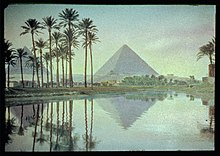
One Egyptian pyramid that is close to a “golden pyramid” is the Great Pyramid of Giza (also known as the Pyramid of Cheops or Khufu). Its slope of 51° 52′ is close to the “golden” pyramid inclination of 51° 50′ – and even closer to the π-based pyramid inclination of 51° 51′. However, several other mathematical theories of the shape of the great pyramid, based on rational slopes, have been found to be both more accurate and more plausible explanations for the 51° 52′ slope.[78]
In the mid-nineteenth century, Friedrich Röber studied various Egyptian pyramids including those of Khafre, Menkaure, and some of the Giza, Saqqara, and Abusir groups. He did not apply the golden ratio to the Great Pyramid of Giza, but instead agreed with John Shae Perring that its side-to-height ratio is 8:5. For all the other pyramids he applied measurements related to the Kepler triangle, and claimed that either their whole or half-side lengths are related to their heights by the golden ratio.[91]
In 1859, the pyramidologist John Taylor misinterpreted Herodotus (c. 440 BC) as indicating that the Great Pyramid’s height squared equals the area of one of its face triangles.[e] This led Taylor to claim that, in the Great Pyramid, the golden ratio is represented by the ratio of the length of the face (the slope height, inclined at an angle θ to the ground) to half the length of the side of the square base (equivalent to the secant of the angle θ).[93] The above two lengths are about 186.4 metres (612 ft) and 115.2 metres (378 ft), respectively.[92] The ratio of these lengths is the golden ratio, accurate to more digits than either of the original measurements. Similarly, Howard Vyse reported the great pyramid height 148.2 metres (486 ft), and half-base 116.4 metres (382 ft), yielding 1.6189 for the ratio of slant height to half-base, again more accurate than the data variability.[86]
Eric Temple Bell, mathematician and historian, claimed in 1950 that Egyptian mathematics would not have supported the ability to calculate the slant height of the pyramids, or the ratio to the height, except in the case of the 3:4:5 pyramid, since the 3:4:5 triangle was the only right triangle known to the Egyptians and they did not know the Pythagorean theorem, nor any way to reason about irrationals such as π or φ.[94] Example geometric problems of pyramid design in the Rhind papyrus correspond to various rational slopes.[78]
Michael Rice[95] asserts that principal authorities on the history of Egyptian architecture have argued that the Egyptians were well acquainted with the golden ratio and that it is part of the mathematics of the pyramids, citing Giedon (1957).[96] Historians of science have long debated whether the Egyptians had any such knowledge, contending that its appearance in the Great Pyramid is the result of chance.[97]
Disputed observations
Examples of disputed observations of the golden ratio include the following:
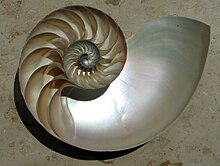
Nautilus shells are often erroneously claimed to be golden-proportioned.
- Some specific proportions in the bodies of many animals (including humans)[98][99] and parts of the shells of mollusks[3] are often claimed to be in the golden ratio. There is a large variation in the real measures of these elements in specific individuals, however, and the proportion in question is often significantly different from the golden ratio.[98] The ratio of successive phalangeal bones of the digits and the metacarpal bone has been said to approximate the golden ratio.[99] The nautilus shell, the construction of which proceeds in a logarithmic spiral, is often cited, usually with the idea that any logarithmic spiral is related to the golden ratio, but sometimes with the claim that each new chamber is golden-proportioned relative to the previous one.[100] However, measurements of nautilus shells do not support this claim.[101]
- Historian John Man states that both the pages and text area of the Gutenberg Bible were “based on the golden section shape”. However, according to his own measurements, the ratio of height to width of the pages is 1.45.[102]
- Studies by psychologists, starting with Gustav Fechner c. 1876,[103] have been devised to test the idea that the golden ratio plays a role in human perception of beauty. While Fechner found a preference for rectangle ratios centered on the golden ratio, later attempts to carefully test such a hypothesis have been, at best, inconclusive.[104][47]
- In investing, some practitioners of technical analysis use the golden ratio to indicate support of a price level, or resistance to price increases, of a stock or commodity; after significant price changes up or down, new support and resistance levels are supposedly found at or near prices related to the starting price via the golden ratio.[105] The use of the golden ratio in investing is also related to more complicated patterns described by Fibonacci numbers (e.g. Elliott wave principle and Fibonacci retracement). However, other market analysts have published analyses suggesting that these percentages and patterns are not supported by the data.[106]
The Parthenon

Many of the proportions of the Parthenon are alleged to exhibit the golden ratio, but this has largely been discredited.[107]
The Parthenon‘s façade (c. 432 BC) as well as elements of its façade and elsewhere are said by some to be circumscribed by golden rectangles.[108] Other scholars deny that the Greeks had any aesthetic association with golden ratio. For example, Keith Devlin says, “Certainly, the oft repeated assertion that the Parthenon in Athens is based on the golden ratio is not supported by actual measurements. In fact, the entire story about the Greeks and golden ratio seems to be without foundation.”[109] Midhat J. Gazalé affirms that “It was not until Euclid … that the golden ratio’s mathematical properties were studied.”[110]
From measurements of 15 temples, 18 monumental tombs, 8 sarcophagi, and 58 grave stelae from the fifth century BC to the second century AD, one researcher concluded that the golden ratio was totally absent from Greek architecture of the classical fifth century BC, and almost absent during the following six centuries.[111] Later sources like Vitruvius (first century BC) exclusively discuss proportions that can be expressed in whole numbers, i.e. commensurate as opposed to irrational proportions.
Modern art

Albert Gleizes, Les Baigneuses (1912)
The Section d’Or (‘Golden Section’) was a collective of painters, sculptors, poets and critics associated with Cubism and Orphism.[112] Active from 1911 to around 1914, they adopted the name both to highlight that Cubism represented the continuation of a grand tradition, rather than being an isolated movement, and in homage to the mathematical harmony associated with Georges Seurat.[113] The Cubists observed in its harmonies, geometric structuring of motion and form, the primacy of idea over nature, an absolute scientific clarity of conception.[114] However, despite this general interest in mathematical harmony, whether the paintings featured in the celebrated 1912 Salon de la Section d’Or exhibition used the golden ratio in any compositions is more difficult to determine. Livio, for example, claims that they did not,[115] and Marcel Duchamp said as much in an interview.[116] On the other hand, an analysis suggests that Juan Gris made use of the golden ratio in composing works that were likely, but not definitively, shown at the exhibition.[116][117][118] Art historian Daniel Robbins has argued that in addition to referencing the mathematical term, the exhibition’s name also refers to the earlier Bandeaux d’Or group, with which Albert Gleizes and other former members of the Abbaye de Créteil had been involved.[119]
Piet Mondrian has been said to have used the golden section extensively in his geometrical paintings,[120] though other experts (including critic Yve-Alain Bois) have discredited these claims.[47][121]
